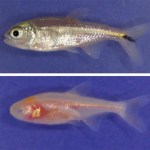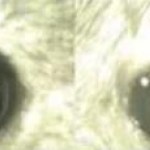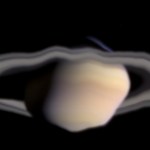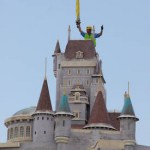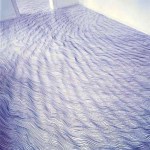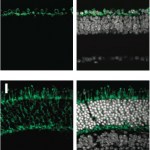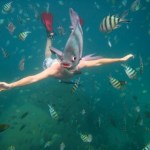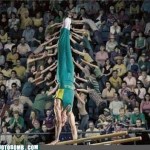Vision
Researchers at Stanford University have accomplished what was once considered impossible. They have partially restored vision in blind. Check out this Youtube video to see how they did it
Image from Wikimedia Commons, Author: Alvesgaspar
New research from the University of Lincoln, UK suggests that cats may prefer to find food using their eyes as opposed to their nose. The preference for vision vs. smell was tested in 6 cats placed in a maze that required cats to make decisions about which way to go based on either images or smells. The researchers observed that 4 out of 6 of the cats chose the visual as opposed to the smell cues to obtain their rewards (food). One cat showed a preference for using its nose, whereas one cat showed no clear …
Image from LiveScience. Credit: Richard Borowsky
Heat shock protein 90 (HSP90) helps keep proteins in the body folded properly and is thought to compensate for variations that occur in proteins over time. In a study published in Science magazine, Dr. Nicolas Rohner and colleagues showed that stress can affect the ability for HSP90 to do its job thereby unmasking these alternative versions of proteins which may lead to adaptation in some cases.
The theory was tested in fish called Mexican tetra (above), some of which adapted to life in caves leading to eventual loss of, or diminished,…
Image from U Penn.
I came across this really interesting press release from the University of Pennsylvania that I just had to share.
Despite having a close relationship with dogs for thousands of years, we are still making new discoveries about our canine friends. Drs. William Beltran (School of Veterinary Medicine), Artur Cideciyan (Perelman School of Medicine), and colleagues teamed up to study canine eyes in an effort to improve treatments for humans with retinal diseases.
Dr. Beltran was quoted as saying “It’s incredible that in 2014 we can still make an anatomical discovery in a…
"It is no good to try to stop knowledge from going forward. Ignorance is never better than knowledge." -Enrico Fermi
As you probably know, the Large Hadron Collider -- site of discovery of the last fundamental particle in the Standard Model, the Higgs Boson -- is the most energetic particle accelerator in the history of humankind. When the upgrades it's currently undergoing are complete, it will reach collision energies of 14 TeV.
Image credit: CERN / LHC, add-on created by http://www.panglosstech.com/.
The way this happens is that protons are circulated in a giant ring, underground,…
The pupils of mice that were injected with the light-sensitive chemical constricted when exposed to bright light (right) in contrast to mice that were not injected (left). Image from Polosukhina et al., 2012.
By injecting the eyes of blind mice with a chemical called AAQ, Dr. Richard Kramer and colleagues at UC Berkeley and the University of Washington have found that the animals are able to detect bright light. When these treated mice were exposed to an LED lamp, they actually turned and ran away from the light. Moreover, their pupils contracted in response to bright light, another…
"All things move and nothing remains still" -- Heraclitus
The history of astronomy can be read as a story of better and better vision. Over the centuries, we have supplemented our vision with technology that allows us to see further and more clearly; while Ancient astronomers, who relied only on their naked eyes to perceive the universe, managed to make star catalogues and predict comets, Galileo, pressing his to a telescope, saw all the way to the moons of Jupiter.
Optical telescopes and the human eye are fundamentally limited; early astronomers were forced to gaze into telescopes for…
Jellyfish aren't reknowned for specialized organs; they lack brains, guts, hearts, and lungs. But some of them have eyes in spades. Mo writes on Neurophilosophy that box jellyfish have "24 eyes contained within a club-shaped sensory apparatus called a rhopalium, one of which is suspended from each side of the cube-shaped umbrella by a flexible, muscular stalk." A crystal called a stratolith weighs down each of the four rhopalia and ensures that the "upper lens eyes remain in a strictly upright position, regardless of body orientation." For the first time, researchers have shown that the…
Ernst Haeckel's Kunstformen der Natur (Artforms of Nature) was a landmark in biological illustration. Published in 1904, it was lavishly illustrated with 100 exquisitely detailed lithographic plates, including this one, showing nine different species of cubomedusae, or box jellyfish.
It has been known, since around the time that Haeckel's masterpiece was published, that box jellyfish have a unique visual system which is more sophisticated than that of other jellyfish species. They boast an impressive set of 24 eyes of four different types, which are clustered within bizarre sensory…
Beautiful video imagining the future of augmented, prosthetic sight, by Superflux for the Human+ exhibition:
Song of the Machine from Superflux on Vimeo.
You can read more about the science behind retinal prosthetics in a great article in the Guardian by one of the project collaborators, Dr. Patrick Degenaar.
Or forced perspective.
I suspect this is more sensitive to viewpoint than the previous post.
-via BoingBoing-
These installations (or more precisely drawings on the floor and ceiling) take advantage of our use of textures to perceive a third dimension/depth out of monocular cues. I'm curious how effective they are from different viewpoints. Perhaps there are some accidental views that make the texture completely boring instead of completely cool.
Here's some great examples:
Check out bookofjoe for some more examples.
-Via Neatorama-
Evolution connects all living things on earth, from the arsenic tolerant bacteria in the news this week to the human scientists and bloggers chatting about it. Eyes are intricately complex structures made up of many many cells, but even single-celled microbes can sense and respond to light through the function of proteins that share evolutionary similarity with the light receptors of the human retina. Incredibly, genetic engineering is showing us just how similar these proteins can be--transferring the genes that code for these processes leads to functional proteins, even when huge…
This (I guess?) accidental view of a San Francisco house really shows how steep the hills are. -Via BoingBoing-
"Håkan Dahlström got this delightful shot of one of San Francisco's steeper hills, turning his camera so that the road (and not the houses) were at level to convey the extent of the slope."
This group can build a 3D model from millions of flickr images from any city/location/public restroom. Amazing!
Scholars at the University of North Carolina at Chapel Hill have developed a method for creating 3D models of pretty much anything in pretty much no time.
Using a sexy algorithm and the millions of photographs available from Flickr, the team can create a sophisticated three-dimensional model on a single personal computer in under a day.
Check out the video:
I love accidental viewpoints. (I studied the opposite in graduate school - the optimum view).
Check these out:
Anyone care to speculate on what's actually going on?
(answer & source here)
